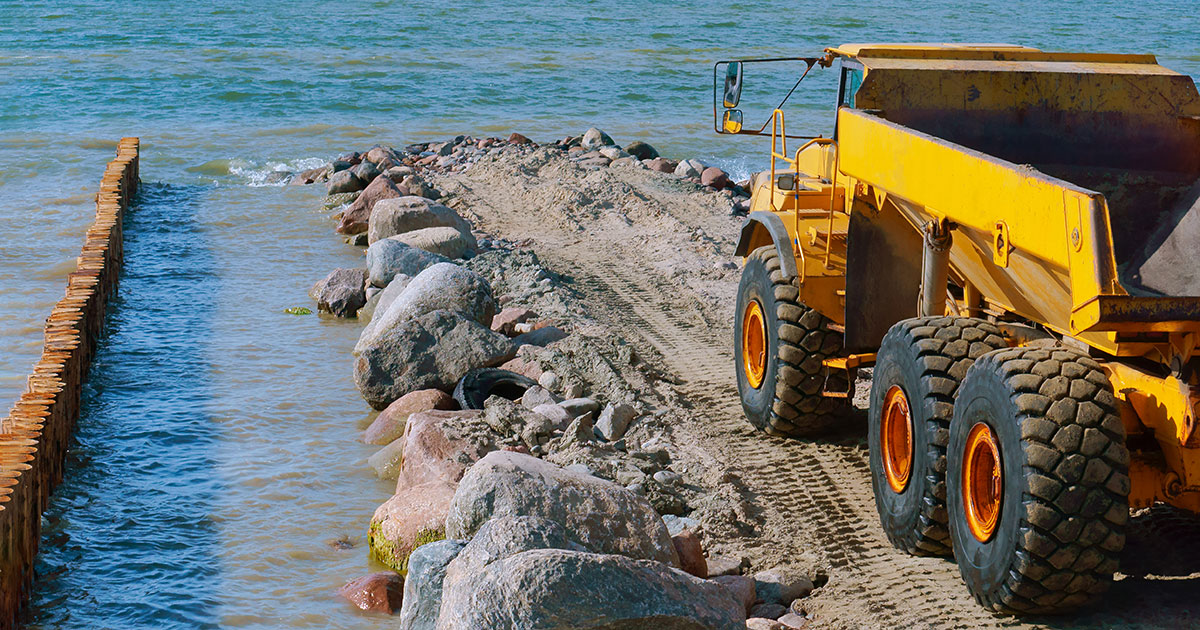
Since graduating from law school and moving to Milwaukee in August, I’ve met several longtime residents who didn’t know Summerfest is not on a natural land formation – it’s built on lakebed fill – or that Lakeshore State Park is also built on lakebed fill, or that Bradford Beach and parts of Lincoln Memorial Drive are located on land that used to be covered by water.
Lakebed Fill and the Public Trust Doctrine
What do all these spaces have in common? They’re public spaces that balance the need for development with the expansion of public rights and access to the iconic Lake Michigan waterfront.
The reason projects on lakebed fill must accommodate the public is because of the public trust doctrine, which is grounded in Wisconsin’s Constitution. This doctrine protects Wisconsinites’ right to fishing and recreation, enjoyment of scenic beauty, navigation, water quality, and water-based commerce.
What is Lakebed Fill?
Now, I’ve said “lakebed fill” a lot so far, but what is it exactly?
 Sarah Martinez, Utah 2021, is a water policy specialist and SeaGrant Water Science-Policy Fellow with the Center for Water Policy at UW-Milwaukee's School for Freshwater Sciences.
Sarah Martinez, Utah 2021, is a water policy specialist and SeaGrant Water Science-Policy Fellow with the Center for Water Policy at UW-Milwaukee's School for Freshwater Sciences.
In Milwaukee, the state legislature granted municipal governments the right to deposit materials, sometimes sediment dredged for shipping channels or harbors, to build new land along the coastline.
What is public enough to satisfy the public trust doctrine on these legislatively-granted areas? Can the state and other developers exclude the public? What are the permissible uses on the newly-created land?
Public Rights in Milwaukee’s Fresh Coast
To elaborate on some of the issues around lakebed fill, the Center for Water Policy at UW-Milwaukee’s School of Freshwater Sciences gathered some of the leading thinkers in this field for an educational CLE Zoom forum that took place Jan. 19, 2022, entitled “Public Rights in Milwaukee’s Fresh Coast.” You can view this program via the YouTube channel for UW-Milwaukee Center for Water Policy.
John Gurda, author of
Milwaukee: A City Built on Water, set the stage. Using his talent for capturing history unlike any other, Gurda presented historic maps of shorelines to demonstrate how they've changed over time. He discussed historic lakebed fill projects and ground the conversation by painting a picture of how the Milwaukee coastline has evolved.
Brenda Coley, co-executive director of the Milwaukee Water Commons, discussed the importance of public rights and access in Milwaukee. Coley is well-versed and dedicated to protecting community members’ access to waterways and working for more green space, especially in actively marginalized communities.
Enter Michael Cain. A retired Wisconsin Department of Natural Resources (WDNR) attorney and current board member of Wisconsin’s Green Fire, Cain discussed the proposals that never came to fruition because they would have violated the public trust. He recapped the WDNR’s practices and policies in dealing with contentious uses of shore lands, and told us how the Riverwalk came to be the valuable asset it is today.
Then current WDNR attorney, Michael Kowalkowski, laid out the policy issues associated with these projects and property disputes that often arise as a result. Kowalkowski is a veteran in permitting and monitoring these types of projects.
Milwaukee and other municipalities are the recipients of lakebed grants. Toni Herkert, government affairs director for the League of Wisconsin Municipalities, discussed the realities of municipal management of lakebed fill, including concerns about funding. We heard her thoughts on how the infrastructure funds may be used, among other things.
I discussed the Milwaukee Estuary Area of Concern, an area of legacy contamination of the rivers’ sediment. Milwaukee is on the verge of an exciting cleanup of its rivers and harbor. I talked about that project and where the dredged contaminated sediment may go, as well as the legal boundaries of that potential new lakebed fill.
Conclusion: We Need this Discussion
There are many moving parts to lakebed fill projects and ongoing management responsibilities for municipalities, but the public trust doctrine remains steadfast throughout.
Take a look at the video and learn about some of the perspectives around these projects, and how lakebed fill might have an impact on your clients.
Here is where to find the program.
This article was originally published on the State Bar of Wisconsin’s
Environmental Law Section Blog. Visit the State Bar
sections or the
Environmental Law Section webpages to learn more about the benefits of section membership.
